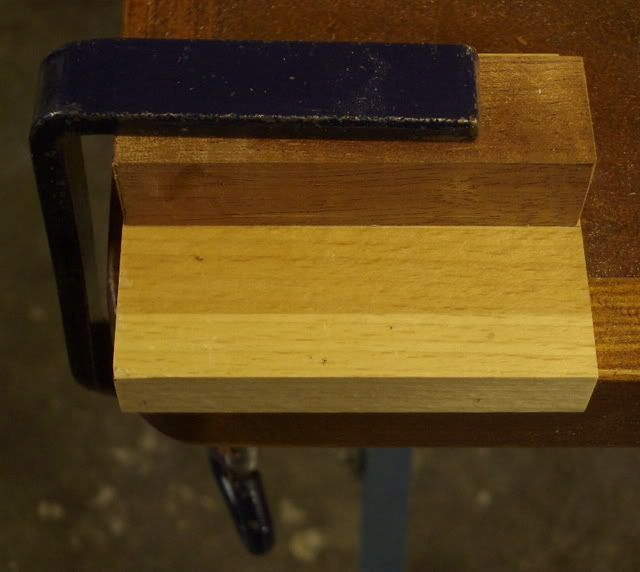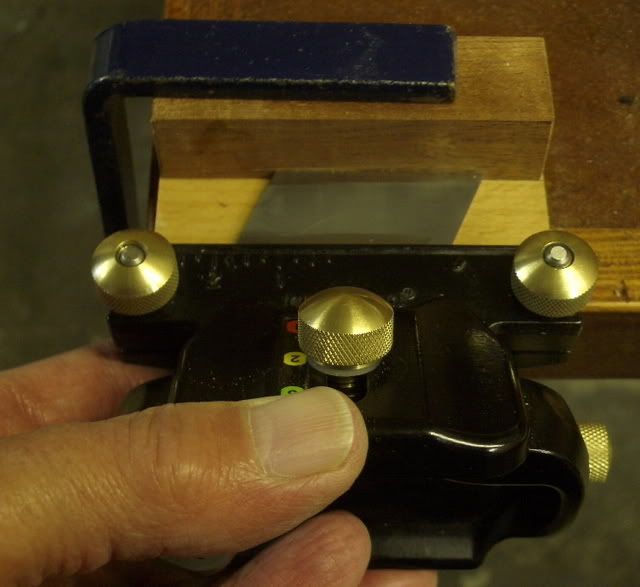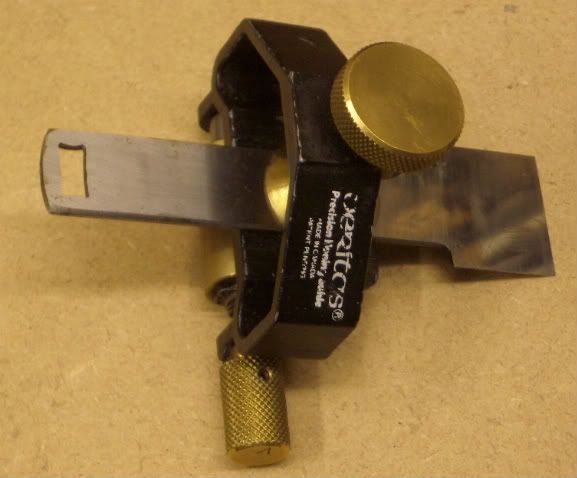I have been happily honing away with my Veritas Guide mk11 without too much worry about squareness of the sharpened blade until I recently bought a large shoulder plane. With this, despite repeatedly checking the setting of the blade against the guide, I am repeatedly sharpening in enough out-of-squareness to make setting it correctly in the plane almost impossible. Does anyone have any experience of this and any advice to resolve this problem?
You are using an out of date browser. It may not display this or other websites correctly.
You should upgrade or use an alternative browser.
You should upgrade or use an alternative browser.
Honing Guide and Squareness
- Thread starter Saint Simon
- Start date

Help Support UKworkshop.co.uk:
This site may earn a commission from merchant affiliate
links, including eBay, Amazon, and others.
If you grind the blade properly square before honing then you should only need to hone a tiny amount to get it sharp - not really enough to put it out of square unless you are putting way too much pressure on one side of the blade.
If the blade is, as it should be, truly square after grinding, then make sure that you are not putting more pressure on one side of the blade than the other during honing.
Cheers,
Marcus
If the blade is, as it should be, truly square after grinding, then make sure that you are not putting more pressure on one side of the blade than the other during honing.
Cheers,
Marcus
bodgermatic
Established Member
I'm only a sharpening newbie, but the advice I have read (and it bears out in my brief experience) is that the honing guide is responsible for bevel angle, you are responsible for squareness. I regularly stop and check the grind and hone for square, and then apply more pressure to one side or the other as required.
Paul Chapman
Established Member
With odd-shaped blades, I think you need to make up a wooden setting block rather than using the metal blade projection jig that comes with the honing guide for setting the blade projection. I made up one to hone the blade of a Veritas skew rebate like this

The front face of the honing guide registers with the edge of the setting block. Insert the blade so that it rests level with the edge of the block, like this

That way, the edge of the blade will always be parallel with the roller and the edge will stay square. You will, of course, need to get your present blade square first.
Hope this helps.
Cheers :wink:
Paul

The front face of the honing guide registers with the edge of the setting block. Insert the blade so that it rests level with the edge of the block, like this

That way, the edge of the blade will always be parallel with the roller and the edge will stay square. You will, of course, need to get your present blade square first.
Hope this helps.
Cheers :wink:
Paul
bugbear
Established Member
Saint Simon":f9a4bnk4 said:I have been happily honing away with my Veritas Guide mk11 without too much worry about squareness of the sharpened blade until I recently bought a large shoulder plane. With this, despite repeatedly checking the setting of the blade against the guide, I am repeatedly sharpening in enough out-of-squareness to make setting it correctly in the plane almost impossible. Does anyone have any experience of this and any advice to resolve this problem?
Is the blade "not square" or does the blade not "fit the plane"?
In planes with low bedding angles, the tiniest side-to-side angle in the bedding results in the blade need some skew in order to project uniformly.
I encountered this having sharpened a blade square to very fine limits when restoring a rebate plane. The blade projection was a county mile away from parallel, and I had to "empirically" rework the blade until the blade projection was parallel.
BugBear
The blade is sharpening not square. The cutting edge comes up not square to the side. Putting aside the projection jig and making my own to set the blade more accurately square to the roller sounds good but as you say I will have to get it square again first. Thanks.

£16.99
£19.99
Respirator Mask,Safety Dust Face Cover,Dust Face Cover Paint Face Cover,Gas Mask With Filter,For Paint,Dust And Formaldehyde,Sanding,Polishing,Spraying And Other Work
ShenZHEN CIRY MINGYANG LITIAN ELECTRONIC ECOMMERCE

£199.00
£360.17
Trend Portable Benchtop Router Table with Robust Construction for Workshop & Site Use, 240V, CRT/MK3
Amazon.co.uk

£10.19 (£0.39 / count)
£11.99 (£0.46 / count)
Nicpro Carpenter Pencil with Sharpener, Mechanical Carpenter Pencils Set with 26 Refills, Case, Deep Hole Marker Construction Pencils Heavy Duty Woodworking Pencils for Architect (Black, Red)
NicproShop EU

£15.99 (£1.60 / count)
£27.44 (£2.74 / count)
3M 8822 Disposable-fine dust mask FFP2 (10-pack)
Amazon.co.uk

£34.99 (£3.50 / count)
£39.99 (£4.00 / count)
VonHaus Chisel Set - 10pcs Woodworking Tools Set - Wood Carving Tools, Wood Chisel Sets with Sharpening Stone, Honing Guide and Storage Case
VonHaus UK

£49.91
£58.33
Mefape Mortise and Tenon Jig Tools for Woodworking Routers, Tenon Cutter, Manual Mortising Machine, Invisible Slotting Machine Jig Stand, 3-Axis Guide Rail for Adjust Trimming Length and Width
wangshijuntianjinhongyuegongyipin

£10.10
£15.48
Portwest Browguard with Clear Visor, Size: One Size, Colour: Clear, PW91CLR
Amazon.co.uk

£24.99
Facemoon Reusable Masks,Safety Masks,Dual Filter Masks, Paint, Dust, Epoxy Resin, Construction, Welding, Sanding, Woodworking, Chemical Reusable Gas Masks
ShenZHEN CIRY MINGYANG LITIAN ELECTRONIC ECOMMERCE

£9.99 (£1.00 / count)
£14.45 (£1.44 / count)
JSP M632 FFP3moulded Disposable Dustmask (Box of 10) One Size suitable for Construction, DIY, Industrial, Sanding, dust protection 99 Percent particle filtration Conforms and Complies to EN 149
Amazon.co.uk
Pete Hughes
Established Member
Hello Paul, how did you get pictures on this forum???
Paul Chapman
Established Member
Pete Hughes":1jmnm4v7 said:Hello Paul, how did you get pictures on this forum???
You need you host your pictures somewhere and then it's easy to copy them to the forum. I use Photobucket http://photobucket.com/?link=topmenu
Cheers :wink:
Paul
woodbloke
Established Member
Once you've copied them into PBucket, right click on the lowest url (img) to copy it and then paste it into your reply. I always use 'Paint' to reduce the image size to 25% before download it into PB - RobPaul Chapman":3tajh9ch said:Pete Hughes":3tajh9ch said:Hello Paul, how did you get pictures on this forum???
You need you host your pictures somewhere and then it's easy to copy them to the forum. I use Photobucket http://photobucket.com/?link=topmenu
Cheers :wink:
Paul
Paul Chapman
Established Member
woodbloke":2285m3zr said:I always use 'Paint' to reduce the image size to 25% before download it into PB
Or you can re-size them in Photobucket - I reduce mine to 640 x480 (I think :? ).
Cheers :wink:
Paul
woodbloke
Established Member
Paul - it then takes a lot longer to load up the original image. If you make it smaller (by 25% or so) re-name it (I usually call my pics small1, small2 etc) you can download them into PBucket from My Pictures far more quickly - RobPaul Chapman":233yx49n said:woodbloke":233yx49n said:I always use 'Paint' to reduce the image size to 25% before download it into PB
Or you can re-size them in Photobucket - I reduce mine to 640 x480 (I think :? ).
Cheers :wink:
Paul
Paul Chapman
Established Member
Thanks, Rob - I'll try that.
Cheers :wink:
Paul
Cheers :wink:
Paul
Handrubbed
Established Member
With the MkII jig it is not so much a matter of getting the blade square initially as it is keeping it square during the honing process. This is true primarily with any blade or chisel that falls into the narrow category. The clamping pressure on the jig is so far outboard that there is insufficient grip over the blade to keep it in position. For the shoulder plane or narrow chisels a side-clamping jig would be the ticket.
Paul Chapman
Established Member
Handrubbed":1resn9yo said:For the shoulder plane or narrow chisels a side-clamping jig would be the ticket.
Or you can use the Veritas Mk1, which clamps from the top with a single screw, so is quite good for shoulder plane blades

It has the adjustable roller, like the one on the Mk2, so you can add a 1 or 2 degree micro-bevel.
You can never have too many honing guides
Cheers :wink:
Paul
Steve Maskery
Established Member
It's very easy with te Veritas MkII, despite the setting gauge, to set the blade incorrectly, simply by applying clamping pressure more on one screw than the other. It's a weakness in an otherwise excellent design. The thing to do is grind to an edge then hone just a couple of strokes. It's enough to see if you getting into trouble or not.
TBH, except for high-angle blades, I've gone back to sharpening by hand. It's like riding a bike, you never forget, just get a bit rusty.
Cheers
Steve
TBH, except for high-angle blades, I've gone back to sharpening by hand. It's like riding a bike, you never forget, just get a bit rusty.
Cheers
Steve
matthewwh
Established Member
FatFreddysCat":1h1p7d5o said:There is hardly anything in the world that some man cannot make a little worse and sell for a little cheaper, and the people who consider price only, are this man's lawful prey.
...and for everyone else, there's Richard Kell !!!
(sorry)
Seriously though, a guide that registers against the back of the blade to give the correct angle, clamps the blade from the sides, and has rollers that are 'outboard' of the blade cannot fail to produce a square edge*.
With only three simple principles to follow I'm constantly amazed at the number of products that only satisfy one or two of them.
Cheers,
Matthew
*assuming that the sharpening media is flat and the blade sides are parallel.
DaveL
Established Member
Matthew,matthewwh":21dwaqo9 said:*assuming that the sharpening media is flat and the blade sides are parallel.
These one of these assumptions causes lots of problems, I am thinking of old woodie irons that where often tapered, making it tricky to set them up in a jig. Paul shows a good jig setting guide, but if you already have a skewed edge, correcting it is hard.
woodbloke
Established Member
Just to go slightly OT a bit Matthew. I know you're a big fan of Richard Kell's guides, and I have to concede that they are beautifully engineered, but they simply don't work on a standard width stone that's raised off the working surface (ie DMT) without installing some kind of parallel outboard runner arrangement for the rollers. I did try a couple of Steve Hamlin's guides last year, but for my sharpening set up, they were just not practical.matthewwh":2rpkq4nr said:...and for everyone else, there's Richard Kell !!!
Seriously though, a guide that registers against the back of the blade to give the correct angle, clamps the blade from the sides, and has rollers that are 'outboard' of the blade cannot fail to produce a square edge*.
With only three simple principles to follow I'm constantly amazed at the number of products that only satisfy one or two of them.
Cheers,
Matthew
That said, if you sharpen using the 'scary sharp' system then the Kell series of guides is ideal - Rob
bugbear
Established Member
There's a presumption here that an accurately straight edge is a design goal.
I'm not so sure about that.
In the case of chisels and bench plane irons, it doesn't matter, as long as you're within "reason", since chisels are used by hand, and bench planes have lateral adjustment.
In the case of low bevel angle planes, it requires extreme machining precision to get the bed such that a straight across edge gives parallel projection. In some shoulder planes without any (significant) lateral adjustment, the only way to make them work is with an accurately skewed blade.
BugBear
I'm not so sure about that.
In the case of chisels and bench plane irons, it doesn't matter, as long as you're within "reason", since chisels are used by hand, and bench planes have lateral adjustment.
In the case of low bevel angle planes, it requires extreme machining precision to get the bed such that a straight across edge gives parallel projection. In some shoulder planes without any (significant) lateral adjustment, the only way to make them work is with an accurately skewed blade.
BugBear
Paul Chapman
Established Member
bugbear":1db3hkmy said:There's a presumption here that an accurately straight edge is a design goal.
I'm not so sure about that.
It depends what planes you are using, BB. On most shoulder planes there is very little lateral adjustment possible and with combination and multi-planes, none at all, so the ability of a honing guide to give you a dead sqare edge can be important. I'm finding that Trend guide particularly good for combination and multi-plane blades, as well as chisels.
Cheers :wink:
Paul
Similar threads
- Replies
- 19
- Views
- 2K
- Replies
- 13
- Views
- 540
- Replies
- 5
- Views
- 258























